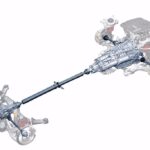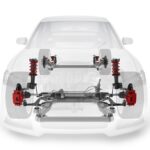Slide 1. Introduction.
The class develops what is the Engine Control Unit (ECU), how it works, how to detect problems, and possible solutions.
Slide 2. How the ECU works.
- What is the ECU and how does it work?.
The engine ECU, although not well known to everyone, is an essential component in automobiles, which monitors and optimizes the internal performance of the vehicle.
This unit plays a crucial role in managing vital functions such as fuel mixture and valve operation, thus ensuring that the car's engine operates at its maximum capacity.
The ECU, or engine control unit, acts as the brain of the vehicle, responsible for monitoring and regulating critical functions for optimum performance of the engine and its components.
Among the main responsibilities of the ECU are the management of engine temperature, revolutions per minute, fuel consumption and gas emissions, among others.
- ECU features.
Among the main characteristics or aspects to be considered about the ECU, we highlight the following:
-
- It is an electronic device located in the engine compartment of the vehicle.
- It controls several aspects of the engine, such as the amount of fuel injected or the oil pressure in the intake manifold.
- It is programmable and can be adjusted to suit different driving conditions and customize vehicle performance.
- It is designed primarily to operate on its own without having to wait for driver intervention.
- ECU operation.
The ECU works in conjunction with a network of sensors distributed throughout the vehicle, which provide it with continuous data on engine status, allowing for almost instantaneous adjustments.
These sensors monitor key aspects such as acceleration, fuel injection, and pressure, gathering essential information for necessary adjustments.
The ECU is also equipped to diagnose faults as soon as the vehicle is started, alerting the driver through indicators on the dashboard, such as the "check engine" light.
Evolution since 1996, with the introduction of electronic fuel injection, vehicles began to incorporate OBD-II systems, which allow the connection of a computer to the ECU for programming and customization via a cable.
- ECU functions.
-
- Ignition verification.
The ECU is the main responsible for setting the time that the spark required in the combustion process should last. To do so, it makes use of the car's data, such as revolutions, current temperature or presence of load in the car. This improves the car's power and fuel efficiency.
-
- Fuel injection control.
In order for the engine to reach the ideal operating temperatures, the ECU is responsible for establishing the amount of fuel to be injected, always depending on the situation in which it is or the use that is being given to the vehicle.
-
- Information storage.
Each of the erroneous or anomalous data is stored in the engine ECU.
-
- Distribution of the valves.
The opening of the valves, as well as the time that they remain in this state, is a decision of the ECU, element that determines the exact period in which the valves must close, optimizing with it the flow of air that enters to make the mixture with the fuel.
We must bear in mind that, in addition to the functions classified on the ECU, there are many others that it carries out, such as receiving data or sending output signals.
- Parts that make up the ECU.
As in most of the parts that make up the car's mechanics, there are several elements that make up the ECU. With regard to the composition of the ECU, we emphasize the importance of each of its parts, since they allow it to perform its functions efficiently and completely.
With this, and keeping in mind the image of the switchboard, similar to a computer, we can highlight its parts as the following:
-
- Power supply:
Element capable of supplying and regulating the electrical energy to the whole of the switchboard.
-
- CPU or Central Processing Unit:
This is a processor, or several, whose function is to receive data, perform the appropriate calculations and send a different response depending on the program.
-
- Storage memories:
We find three different types of storage memories in the ECU control unit, distinguished as follows:
1. RAM or random access memory:
It can be written and rewritten many times, that is to say, the data that it introduces are of temporary character.
2. ROM or read-only memory:
As its name suggests, this type of memory has only the basic information.
3. EEPROm or programmable memory:
Manipulable at the time of wanting to reprogram or clone the control unit. The information presented can be changed.
-
- Input interface:
Element capable of receiving all the signals sent by the sensors, converting them into digital for the compression of the CPU.
-
- Output interface:
It converts the digital signals and the CPU, mentioned above, with the objective that the sensors and actuators of the engine can understand them, as well as other type of elements controlled by the ECU.
Together with the aforementioned elements, we also highlight other types of electronic components present in the ECU, such as capacitors, drivers, and diodes, being elements that allow supplying power to the ECU, keeping it in good condition, protecting it and coordinating its components.
- How to detect problems in the ECU.
It is essential to detect any problems in the ECU in time to keep the vehicle in optimal conditions. Some warning signs include:
-
- Difficulty starting the vehicle.
In the event of a fault in the ECU, and since it is responsible for controlling the engine ignition process, problems will be experienced when starting the car.
-
- High fuel consumption.
- Loss of power and irregular acceleration.
The ECU is responsible for controlling fuel injection, ignition and other engine parameters. If this element fails, engine power will be affected.
-
- Activation of warning lights such as "check engine".
- Excessive smoke emission from the exhaust, indicating combustion problems.
- Failure of electronic accessories, such as air conditioning or radio.
- Transmission problems:
Although not in all, in many cars the ECU controls the transmission, if this is your case and the part presents a fault, it could derive in abrupt gear changes or loss of the proper gear.
- Diagnosis of the ECU How is it carried out?
Many users are unaware of the steps to be followed to diagnose the ECU, but it can be done with the use of specific tools, such as diagnostic scanners or programs specially designed for this purpose.
With this, and making use of the tools mentioned above, we can follow these steps to diagnose the ECU:
-
- Connect the scanner to the car's OBD diagnostic port, usually located under the dashboard or on the engine.
- Perform the reading of the error codes with the diagnostic scanner. These are numeric codes that indicate the problem the car is experiencing.
-
- To interpret the error codes:
To do this, we must make use of a table of error codes, thereby determining the specific problem.
-
- Perform additional tests:
Once the problem has been identified, it may be necessary to perform additional tests to find out the real cause of the problem.
Remember, ECU diagnosis is a process that requires technical knowledge and experience.
- Solutions to ECU failures.
If problems with the ECU are detected, there are several repair strategies:
-
- Replacing damaged sensors or updating the ECU software.
- Cloning the ECU information into a new unit in case of severe damage.
- Resetting the ECU, especially if the data is unrecoverable.
- Complete ECU replacement if the problem is severe.
It is crucial to turn to qualified professionals for any ECU diagnosis or repair to ensure proper troubleshooting.
- What is the life span of the ECU.
There are several factors that influence the useful life of the ECU, because depending on the quality of the part, the conditions of use and maintenance of the car, its duration will be one or another.
Taking into account the above, and in general, we can say that the useful life of the engine control unit is usually about 100,000 kilometers, and it can be longer if it is kept in perfect conditions and driven efficiently.
Did you know that the design of the ECU is made to last for a long period of time? Do not forget that, by carrying out a correct maintenance on the part, as well as making the corresponding revisions, the duration will increase.
- How much does it cost to replace the ECU?
The change or replacement of the engine control unit is one of the most expensive that we can find, being the cost of the part between 1,000 and 3,000 euros, depending on the make and model of car.
Together with the above, and provided that we are not going to make the change ourselves, we must add to the price mentioned above, the cost of labor, which can amount to a total of between 2,000 and 4,000 euros.
- Fleet management implications.
Although it may go unnoticed by many, the ECU is a critical component in the performance and efficiency of modern vehicles.
If the ECU is not functioning properly the vehicle can have a multitude of failures and malfunctions causing the vehicle to be unusable for service.
It is very important for the ECU to be in perfect working condition, to perform maintenance according to the manufacturer's instructions and within the recommended mileage.
It is also recommended to perform preventive maintenance to find possible faults in the ECU.
Slide 3. Thank you for your time.
The class has developed what the ECU is, how it works, how to detect problems, and possible solutions, see you soon.
Download the audio




















